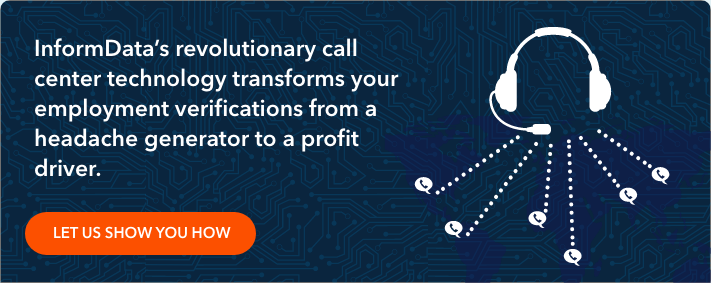For the typical verifications agent working for a typical CRA (consumer reporting agency), the workday begins with looking through their queue, strategizing the best time to call each source, accounting for time zones, each source’s availability, and individual clients’ preferred procedures. The call center’s cubicles are lined with sticky notes and pinned-up papers detailing complex calling instructions.
It’s no wonder that in the world of background checks, employment and education verifications are among the most headache-inducing, time-consuming, complicated, and difficult-to-scale services a CRA can provide.
But that’s a typical CRA.
A typical day in the InformData verifications call center begins differently. There’s no need to formulate a calling plan and no written instructions. An InformData verifications specialist simply launches their automated calling software with a click and follows the on-screen prompts. As soon as one call ends, the next is ready to be connected.
The difference: state-of-the-art call center technology.
“One of the things that sets us apart from a traditional CRA is the fact that we have incorporated and invested in a dialer,” said Jamie Cover, InformData's Director of Verifications Operations.
InformData’s advanced call center technology is built on the same cutting-edge platforms that some of the world’s most efficient and effective customer service organizations use. For CRAs and background screening companies, the result is faster turnaround times, greater scalability, better reliability, and the ability to fulfill nearly any customization request.
During a recent episode of Inform Yourself (our podcast about everything background screening), Jamie offered us a look under the hood.
The following has been condensed and edited for length and readability.
Why is InformData’s call center technology so much faster and more accurate compared to the typical CRA’s manual process?
“You gain efficiency when you’re using a dialer versus having to look at a piece of paper, punch in a number, and then call it,” Jamie said. “There’s also error handling. People can mistype numbers. Our system won’t do that.”
Can you describe how the technology works from a caller’s perspective?
“The entire system is scripted,” Jamie said. Moreover, the script is color-coded. Questions are highlighted in yellow. Questions that are meant to be read verbatim are in orange.
“So, it’s very quickly identifiable by our agents what they can paraphrase and what they can’t,” Jamie said.
Following the script becomes second nature very rapidly for InformData’s agents.
“The system tells them what to say. It gives them the name of the applicant. It gives them the order number. It gives them the callback number. It gives them all that information, so they don’t have to look at different places on the screen,” Jamie told us.
Do the verifications specialists have to worry about customizations?
“Client customizations are all done on the back end,” Jamie explained. For an agent, she said, “Every case they work is roughly going to look the same as the case they worked before, although the questions may change. For example, many clients now are not asking for salary information, so that question may not populate. Things like that are very easy to do in the system, so our agents do not have to remember.”
What else can be customized behind the scenes?
“Pretty much whatever the client can think of can be customized,” Jamie said. “Whether it’s the scripting you want customized, the notes, or something else. One of the examples I use is when we do a high school verification, we typically report ‘diploma.’ But some CRAs want us to report ‘high school diploma.’ We can do that all behind the scenes, so it comes to the CRA the way they want.”
The customization can get extremely granular; it can be end-user or even order-type-specific. The calling pattern can also be customized.
“Maybe, to win business through an RFP, you have some sort of crazy calling pattern: ‘Call on day one and two, skip days three and four, call on day five and six, and then close out the order on day nine,’” Jamie described. “We can configure our system to handle things like that and help our CRA clients meet any demand their end-users may put on them.”
To what extent are InformData’s CRA clients in control of how verification data is reported?
Along with an API-first framework, InformData puts CRAs in control of reporting with user-defined fields. With user-defined fields, CRAs can ensure data is formatted to align with their internal processes.
“CRAs can create user-defined fields that can populate based on outcomes of calls or different scenarios,” Jamie explained. “CRAs can use those fields to facilitate internal routing or adjudication. This is a really powerful tool for our clients because they want to outsource to us, but they don’t want to have to do additional work once the report comes back in.”
For example, if an inquiry comes back as “no record” due to a computer system change, a user-defined field may flag the report so that the CRA knows to reach out to the applicant for documentation.
The sheer volume of verifications that flow through InformData’s system must generate an immense amount of data. How does InformData use that data to optimize the verifications process?
“Among other things, we do a lot of analysis around when we have the best success rate so that we can staff for that,” Jamie said. “For example, we find that we can staff fewer people in the mornings and then increase our staff to take advantage of the prime calling hours between 10 a.m. and 3 p.m.”
But the real difference maker with InformData’s state-of-the-art technology? “It’s the fact that our system learns.”
For example, as Jamie explained, if InformData learns that a particular employer prefers to verify via fax, requires release, and has a 24-hour turnaround time, that information is saved in the calling system.
“So next time we get that company, our system says, ‘Hey, you did this two weeks ago and successfully verified it by sending it to this fax number. Do you want to send it that way again?’” she said. In this scenario, the fax would be sent out automatically before the calling attempts begin. “What that does is it gets the verification to where it needs to go before we start calling, helping us decrease turnaround time and improve efficiency.”
InformData focuses on constant improvement, using data and technology to optimize the research process, get phone numbers faster, and gain as much information as possible.
Whereas the typical CRA has so many demands on their time and resources, “For those of us on the InformData verifications team, our mind is solely focused on verifications,” Jamie said. “How do we get the best product for our clients? How do we help them improve the verifications headache, and how do we get them the best turnaround time? How do we constantly evolve to show that we’re good partners?”
If you’re interested in exploring a partnership with InformData, click here.


